| Columns Retired Columns & Blogs |
Ayre C-5xe universal disc player Measurements
Sidebar 3: Measurements
The Ayre C-5xe's maximum output level at 1kHz was the same for both CD and DVD-Audio LPCM data—4.16V from the balanced XLR jacks, 2.103V from the unbalanced RCA jacks—but just under half that figure for SACD playback: 1.95V and 970mV, respectively, measured using Sony's "provisional" Test SACD. Unless compensated for, this difference in level will obscure any differences heard in comparisons of the different media. Both sets of outputs preserved absolute polarity—ie, were noninverting—with all three media, and the XLRs are wired with pin 2 positive, the AES standard. The output impedances were slightly higher than specified, at 93 ohms unbalanced and 187 ohms balanced (both figures include the series resistance of 2m of interconnect), but were still low in absolute terms.
Error correction, assessed using the Pierre Verany test CD and monitoring the error flag in the datastream available from the Ayre's digital output jack with RME's DigiCheck software, was disappointing. The player coped with gaps in the CD's data spiral of only up to 0.5mm without concealed errors or audible glitches.
The Ayre's frequency response for CD playback differed according to whether the rear-panel DIP switch was set to Listen or Measure. In the Measure position, the response was flat up to 10kHz, with then a slight top-octave droop reaching –0.5dB at 20kHz (fig.1, top pair of traces). Set to Listen, however, the output above 15kHz dropped significantly, to –3dB at 20kHz. This kind of response is not that audible in itself. However, I am becoming convinced that the better time-domain performance offered by the digital filter that produces this response does sound better, particularly regarding accuracy of stereo imaging. The response in Measure mode with pre-emphasized data (fig.1, bottom traces) didn't differ significantly from that with regular data.
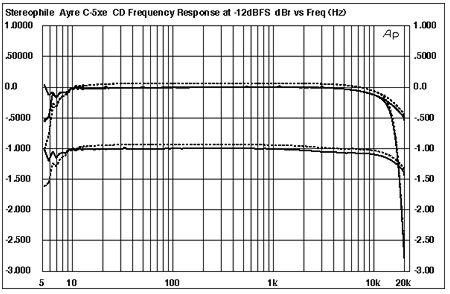
Fig.1 Ayre C-5xe, CD frequency response at –12dBFS into 100k ohms, with de-emphasis (bottom) and without, set to Measure (top at 20kHz) and Listen (bottom at 20kHz). (Right channel dashed, 0.5dB/vertical div.)
Fig.2 shows the extended high-frequency response delivered by the C-5xe with SACD and DVD-A. The filter switch has no effect on SACD playback, which smoothly extends up to 80kHz in this graph, with a –3dB point of 50kHz. However, while DVD-A playback set to Measure maps the SACD response up to 45kHz, where it drops precipitously (fig.2, middle traces), with the filter set to Listen the ultrasonic output rolls off earlier, reaching –3dB at 38kHz. I feel it safe to say that this response difference will not be audible in itself. Again, however, the better time-domain performance of this kind of digital filter might well be audible.
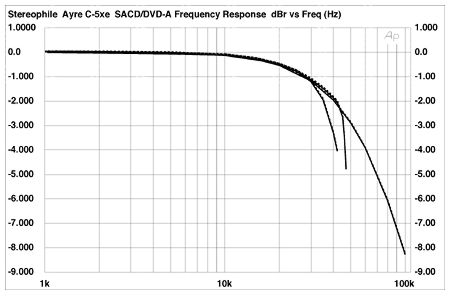
Fig.2 Ayre C-5xe, SACD frequency response at –3dBFS into 100k ohms (top at 50kHz) and DVD-A frequency response at –12dBFS into 100k ohms, set to Measure (bottom at 45kHz) and Listen (bottom at 40kHz). (Right channel dashed, 0.5dB/vertical div.)
Channel separation was superb, any crosstalk being buried beneath the C-5xe's noise floor in the audioband. And that noise floor was low. Fig.3 shows 1/3-octave spectral analyses of the Ayre's output while it decoded data representing a dithered tone at –90dBFS on CD, SACD, and DVD-A. The top pair of traces below 6kHz and above 100Hz in this graph were taken with 16-bit CD data. The traces are free from harmonic-distortion spuriae, and—other than a power-supply–related peak at 60Hz, this higher in the left channel than in the right—merely show the effect of the dither noise recorded on the CD. (As the 60Hz spuriae lie at –120dBFS or lower, they can be ignored.)
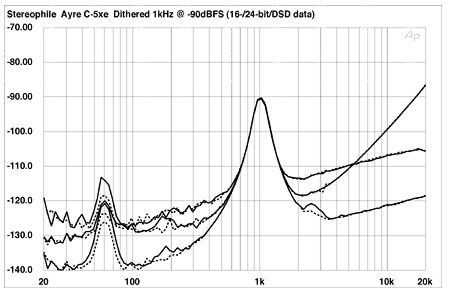
Fig.3 Ayre C-5xe, 1/3-octave spectrum of dithered 1kHz tone at –90dBFS, with noise and spuriae, 16-bit CD data (top below 6kHz), 24-bit DVD-A data (bottom), DSD data (top above 6kHz and below 100Hz). (Right channel dashed.)
Increasing the word length to the 24 bits possible with DVD-A (I burn my own test DVDs using Minnetonka Software's Discwelder Bronze program) gave the lowest pair of traces in fig.3. The 60Hz peaks overlay those in the CD traces, but otherwise, the increase in bit depth gives a corresponding increase in dynamic range of more than 12dB, which is excellent. The spectrum for DSD data (fig.3, middle traces below 6kHz) is compromised a little by the lower playback level for this medium—note the 6dB rise in level of the 60Hz peak. Even so, SACDs played back on the C-5xe still offer greater dynamic range than CDs—except in the top two octaves, where the DSD encoding's noiseshaping starts to have an effect.
Linearity error for CD playback was below the level of the dither noise recorded on the CBS Test CD 1 (fig.4). In fact, the Ayre's DACs offer excellent performance. The waveform of an undithered tone at exactly –90.31dBFS, which is described by just three voltage levels with 16-bit CD data, was essentially perfect (fig.5), while increasing the bit depth to 24 gave a good-looking sinewave (fig.6). Repeating this test with dithered DSD data gave a similarly excellent sinewave, though with more high-frequency noise apparent (not shown).
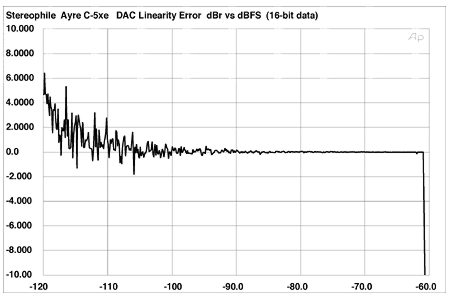
Fig.4 Ayre C-5xe, right-channel departure from linearity, 16-bit CD data (2dB/vertical div.).
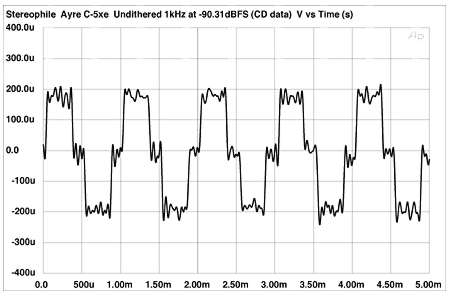
Fig.5 Ayre C-5xe, waveform of undithered 1kHz sinewave at –90.31dBFS, 16-bit CD data.
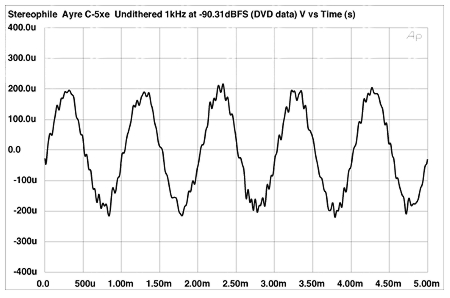
Fig.6 Ayre C-5xe, waveform of undithered 1kHz sinewave at –90.31dBFS, 24-bit DVD-A data.
With its use of what I believe is low-feedback circuitry, the Ayre has a little more harmonic distortion present in its output than is usual. Fig.7, for example, is an FFT-derived spectrum of its output while it drove a maximum-level 1kHz tone from its unbalanced output jacks into a fairly low 4k ohm load, set to Measure. The second harmonic is the highest in level in the right channel, at –76dB (0.02%); the third harmonic is highest in the left channel, at –80dB (0.01%). These are still low levels of distortion in absolute terms, however. To my surprise, the balanced outputs offered slightly higher levels of distortion, the second harmonic in the left channel lying at –70dB (0.03%), even into 100k ohms (not shown). Reducing the load impedance to a punishing 600 ohms raised the second and third distortion harmonics to –60dB (0.1%), suggesting that the Ayre be used with moderately high-impedance loads.
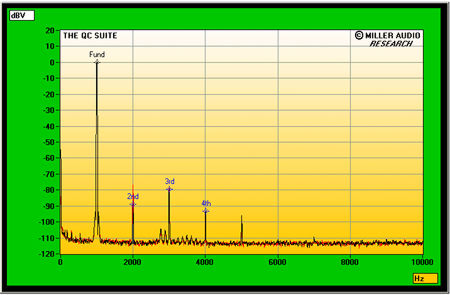
Fig.7 Ayre C-5xe, Measure, spectrum of 1kHz sinewave, DC–10kHz, at 1V into 4k ohms (linear frequency scale).
Levels of intermodulation distortion were also a little higher from the balanced than the unbalanced outputs, but, perhaps more important, varied with PCM data according to whether the digital filter was set to Measure (fig.8) or Listen (fig.9). The level of the second-order difference component at 1kHz resulting from an equal mix of 19 and 20kHz tones wasn't affected, and was low at –94dB (0.002%) left and –84dB (0.006%) right. But with the "leakier" low-pass filtering associated with its better time-domain performance, the Listen filter allows a greater amount of aliasing between the signal components and the sample frequency. The jury is out on whether this will have a negative effect on a component's sound, but it is fair to point out that, with the exception of the tone at 24.1kHz, the level of these spuriae in the C-5xe's output is very low.
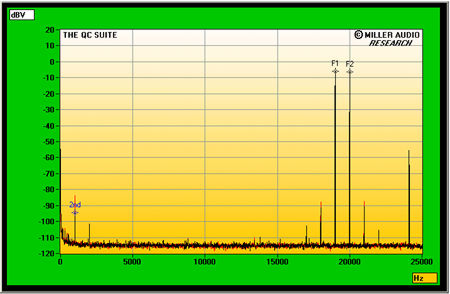
Fig.8 Ayre C-5xe, Measure, HF intermodulation spectrum, DC–24kHz, 19+20kHz at 1V peak into 4k ohms (linear frequency scale).
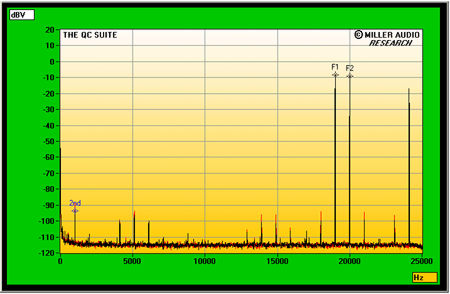
Fig.9 Ayre C-5xe, Listen, HF intermodulation spectrum, DC–24kHz, 19+20kHz at 1V peak into 4k ohms (linear frequency scale).
Finally, the Ayre C-5xe offered low levels of word-clock jitter. Using the Miller Audio Research Jitter Analyzer with suitable test signals on CD and DVD-A, I measured 289 picoseconds peak–peak both for 16-bit CD playback and 24-bit DVD playback. This is a little more than twice the lowest jitter I have measured with this test set, but is still low in absolute terms. Fig.10 shows a narrowband spectral analysis of the C-5xe's single-ended analog output while it decoded 24-bit/44.1kHz data representing a high-level 11.025kHz tone over which has been laid a low-frequency squarewave at the LSB level. Four pairs of sidebands—at ±15.6Hz (purple "1" markers), ±889Hz (purple "6"), ±1298Hz (purple "7"), and ±1310Hz (purple "8")—contribute almost all the measured jitter energy. I have no idea what mechanism causes these sidebands, but changing to a 16-bit representation of the same signal (grayed-out trace in fig.10) didn't change the picture to any significant extent, other than the expected rise in the data-related sidebands (red circles).
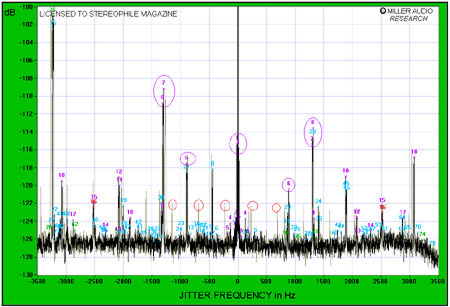
Fig.10 Ayre C-5xe, high-resolution jitter spectrum of analog output signal (11.025kHz at –6dBFS sampled at 44.1kHz with LSB toggled at 229Hz, 24-bit DVD-A data). Center frequency of trace, 11.025kHz; frequency range, ±3.5kHz. Grayed-out trace is 16-bit CD data.
Given the disappointing performance of some other universal players I have measured recently—see, for example, the review of the McCormack UDP-1 in our January 2005 issue—the Ayre C-5xe's measured performance offers no compromises. I was puzzled by the designer's decision to reduce the playback level for SACDs compared with CDs and DVD-As, but this will not adversely affect sound quality. A nicely engineered piece of kit!— John Atkinson
- Log in or register to post comments




































